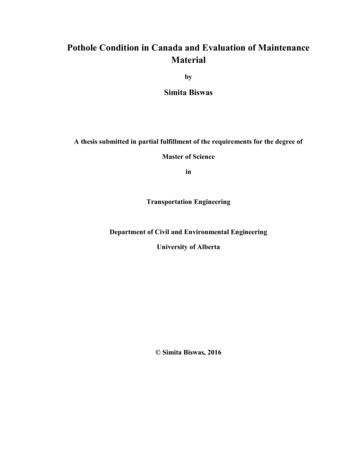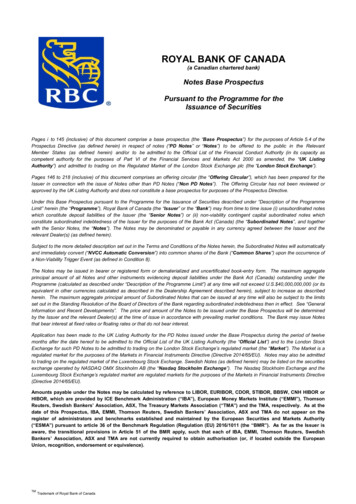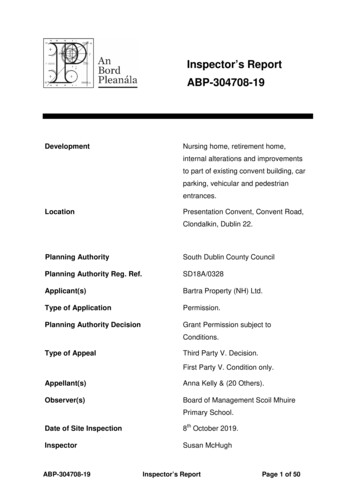
Transcription
Pothole Condition in Canada and Evaluation of MaintenanceMaterialbySimita BiswasA thesis submitted in partial fulfillment of the requirements for the degree ofMaster of ScienceinTransportation EngineeringDepartment of Civil and Environmental EngineeringUniversity of Alberta Simita Biswas, 2016
ABSTRACTPotholes are one of the most concerning deteriorations of asphalt pavement in coldclimatic regions. Repair of potholes is an important form of maintenance operations forasphalt pavements conducted by most of the transportation agencies. Although a largenumber of previous researches including field monitoring, laboratory testing andquestionnaire survey were conducted for the past three decades to study pothole repair inspecific parts of the United State and Europe, limited research efforts have been devotedto inspect the severity of the pothole problem and its maintenance practice in Canada.Therefore, this research work attempts to investigate pothole severity, conduct criticalassessment of current maintenance practices and identify resources available for potholerepair throughout Canada. In order to attain the main objective of this study, aquestionnaire was prepared and distributed to Canadian transportation agencies.According to the survey outcomes from six provinces (Alberta, Manitoba, Ontario,Quebec, Saskatchewan and New Brunswick), a greater percentage of moderate to highsevere potholes was noticed in the study area. Freeze-thaw cycle was identified as themost influential factor in pothole formation, and a large portion of pothole repairs wastypically performed in the summer period. Moreover, the study results identified the mostfrequently used patching materials and methods in these provinces and patch durability.Inadequate stability, adhesion, cohesion and stripping potential of patching materials andimproper compaction during patching operations were determined to be the main reasonsof patch failure based on the concerning distresses of the repaired patch. To evaluate theperformance of patching material, a laboratory testing program was conducted on coldmixes that were identified as being most frequently used by the survey. The laboratoryresults showed that curing time and temperature had a significant effect on strength gainii
for all cold mixes. Substantial freeze-thaw damage potential was also noticed for the coldpatching materials.iii
PREFACEArticle submitted to refereed journal1. Biswas, S., Hashemian, L., Hasanuzzaman, M., and Bayat, A., (2015). A Study onPothole Repair in Canada through Questionnaire Survey and LaboratoryEvaluation of Patching Materials. Canadian Journal of Civil Engineering. UnderReview.2. This thesis is an original work by Simita Biswas. The research project, of whichthis thesis is a part, received research ethics approval from the University ofAlberta Research Ethics Board, Project Name “Pavement maintenance for potholein cold climate”, No. 00048652, August 21, 2014.iv
Dedicated to my parents and husbandv
ACKNOWLEDGEMENTSFirst and foremost, I praise God, the almighty for providing me this opportunity andgranting me the capability to complete my research work successfully. I would like toexpress my sincere appreciation and deepest gratitude to my advisor, Dr. Alireza Bayat,for his support, help and guidance during my graduate study. His guidance has made mylearning experience a very special one and I am truly fortunate to have had theopportunity to work with him. I would like to thank my defence committee members, Dr.Yasser Mohamed (chair and examiner) and Dr. Yuxiang Chen (examiner) for theirsupport, suggestions and encouragement. I would also like to thank Dr. Leila Hashemianfor her friendly guidance, valuable suggestions and constructive criticism throughout theprogress of the study.I would also like to acknowledge Alberta Transportation, Manitoba Infrastructure andTransportation, Ontario Ministry of Transportation, Quebec Ministry of Transportation,Saskatchewan Ministry of Highways and Infrastructure, and New Brunswick Departmentof Transportation and Infrastructure for their assistance and time to participate in thequestionnaire survey. My appreciation is also extended to Mr. Al Cepas for hiscontinuous help and valuable suggestions during the preparation and distribution of thesurvey. I am also thankful to Ms. Tatiana Boryshchuk and Ms. Sheena Moore for lendingtheir editorial assistance in the review of this thesis.Finally, I want to express my deep gratitude to my friends and family who always loved,supported and encouraged me throughout this challenging process.vi
TABLE OF CONTENTSABSTRACT . iiPREFACE . ivACKNOWLEDGEMENTS . viTABLE OF CONTENTS . viiLIST OF TABLES . xLIST OF FIGURES . xiChapter 1.Introduction . 11.1.Background . 11.2.Problem statement . 31.3.Objectives . 41.4.Methodology . 51.5.Organization of the thesis . 5Chapter 2.Literature Review . 72.1.Flexible pavement distresses . 72.2.Definition and types of potholes . 82.3.Formation of potholes . 92.4.Pothole repair . 112.4.1.Pothole patching seasons . 122.4.2.Pothole patching materials . 122.4.3.Pothole patching techniques. 172.5.Causes of repaired patch failure . 202.6.Previous studies . 23Chapter 3.Investigation on Pothole Maintenance in Canada throughout QuestionnaireSurvey28vii
3.1.Abstract . 283.2.Introduction . 283.2.1.Background . 283.2.2.Previous studies . 313.2.3.Objectives and scope . 323.3.Population, land area and weather in Canada. 333.4.Questionnaire survey on pothole maintenance . 353.4.1.Questionnaire result . 363.5.Discussion . 483.6.Conclusion . 50Chapter 4.A Study on Pothole Repair in Canada through Questionnaire Survey andLaboratory Evaluation of Patching Materials . 524.1.Abstract . 524.2.Introduction . 524.2.1.Background . 524.2.2.Previous studies . 544.2.3.Objectives and scope . 554.3.Questionnaire survey results . 564.3.1.Pothole repair . 564.3.2.Performance of different repair techniques . 594.4.Laboratory tests . 604.4.1.Material properties . 604.4.2.Marshall Stability testing . 624.4.3.Indirect tensile strength testing . 644.4.4.Adhesiveness testing . 67viii
4.4.5.Cohesion testing . 694.5.Discussion . 714.6.Conclusions . 72Chapter 5.Summary and Conclusion . 745.1.Summary . 745.2.Conclusion . 755.3.Future research . 77References . 78Appendix A . 84Appendix B . 92ix
LIST OF TABLESTable 2-1: Pothole patching mixture characteristics for different parameters of materialproperties (Marcus and Elizabeth 2001) . 14Table 2-2: Laboratory test results of cold patching materials (Maher et al. 2001) . 25Table 2-3: Workability, cohesion and coating test results of cold patching materials(Marcus and Elizabeth 2001) . 26Table 3-1: Climatic zones for individual provinces in Canada . 35Table 3-2: Network size maintained by different organizations . 36Table 3-3: AADT, percentage of truck traffic, kilometer length and percentage of totalnetwork of major arterial roadways . 37Table 3-4: Present conditions of roadways in different provinces according to PQI(Pavement Quality Index) or PSR (Present Serviceability Rating) . 37Table 3-5: Pavement types in different provinces by percent . 38Table 3-6: Thickness of asphalt layer for different classes of roadway. 39Table 3-7: Rating of probable causes of pothole development in different provinces(Scale: 1 to 5, where 5 is most important cause) . 40Table 3-8: Percentage of potholes in three categories of severity . 42Table 3-9: Periods of pothole repairs . 43Table 3-10: Pothole repair materials used in summer and winter in six provinces inCanada. 44Table 3-11: Pothole patching methods for winter repair . 44Table 3-12: Survival periods of repaired patches for provinces in Canada . 45Table 3-13: Rating of probable causes of repaired pothole failure (Scale: 1 to 5, where 5is most important cause) . 46Table 4-1: Pothole repair periods, materials and methods in six provinces of Canada . 58Table 4-2: Survival period of repaired patch for provinces in Canada . 59Table 4-3: Sieve analysis results of granular aggregate for CCM, HMA, QPR and IAR 61x
LIST OF FIGURESFigure 2-1: Potholes in different severity categories (Miller and Bellinger 2003) . 9Figure 2-2: Development of a pothole . 10Figure 2-3: Pothole repair procedure of throw-and-go method (Wilson and Romine 2001). 18Figure 2-4: Pothole repair procedure of semi-permanent method (Wilson and Romine2001) . 19Figure 2-5: Spray injection patching procedure and devices available for pothole repair(Maupin et al. 2003, Wilson and Romine 2001). 20Figure 2-6: Distresses on a repaired patch (Maher et al. 2001) . 22Figure 2-7: Percentage of repaired patch failed after an observation period of 18 monthsby (a) patching method and (b) patching materials (Wilson and Romine 1993) . 24Figure 3-1: Distribution of (a) population and (b) land area in Canada . 33Figure 3-2: Plot of annual temperature and precipitation for provinces in Canada . 34Figure 3-3: Plot of annual snowfall for provinces in Canada . 34Figure 3-4: Average rating of probable causes of pothole development in differentprovinces (Scale: 1 to 5, where 5 is most important cause) . 41Figure 3-5: Average rating of probable causes of repaired pothole failure (Scale: 1 to 5,where 5 is most important cause). 48Figure 4-1: Marshall Stability and flow test procedure . 63Figure 4-2: Marshall Stability of different patching materials . 64Figure 4-3: Moisture susceptibility test procedure . 66Figure 4-4: (a) Tensile strength and (b) TSR of different materials . 67Figure 4-5: Adhesion test procedure . 68Figure 4-6: (a) Adhesion time and (b) Measure of remnant weight of different coldpatching materials . 69Figure 4-7: Cohesion test procedure . 70Figure 4-8: Value of retained material for different cold mixes . 71xi
Chapter 1. Introduction1.1.BackgroundPavement maintenance for potholes is currently an important issue, especially in coldregion areas where adverse weather conditions significantly contribute to thedevelopment and acceleration of the pothole problem. Deterioration of pavement isgenerally defined as a process of distress development due to the combined effects ofpavement materials, subgrade soil condition, traffic loading and environmental factors.Asphalt pavement surface distresses are categorized into four types of deteriorationsnamed as cracking, surface deformation, surface defects and disintegration. One of themost concerning pavement disintegrations in cold weather regions, potholes, is the mainfocus of this thesis. Potholes are bowl-shaped depressions of varying sizes that penetrateall the way through the surface layer down to the base course, frequently encountered onthe surface of flexible pavements (Miller and Bellinger 2003). Formation of potholes notonly decreases the service life of pavement but also significantly reduces the performancelevel of roads. It can begin from more severe interconnected alligator and longitudinalcracks and raveling of pavement surface. Additionally, water penetrating into the toplayer of asphalt through the cracks also causes the development of potholes. Freeze-thawcycles accelerate the process of pothole formation; late winter and early spring areconsidered as the freezing and thawing period, respectively (Maher et al. 2001). Materialand thickness of pavement structure, traffic loading, inappropriate repair of pavementdistresses, pavement age, rate of precipitation and winter maintenance are alsoresponsible for acceleration of pothole development (Paige-Green et al. 2010).Pothole patching is a well-known asphalt pavement maintenance operation in coldclimatic regions. The two main components of pothole repair operations are patchingmixtures and methods (Wilson and Romine 2001). The widely used patching materials inthe United States and Canada are proprietary cold mixes produced with emulsified orcutback bitumen to increase workability in cold weather and antistripping agents toreduce moisture susceptibility (Prowell and Franklin 1996). Hot mixed asphalt (HMA)1
produces a more durable and longer lasting patch than the cold mixes. Potholes are filledfollowing different procedures in different seasons. The „throw-and-go‟ is the simplestand most widely used patching method. The repair procedure includes placing materialinto the pothole, compacting it using truck tires and leaving a 3 to 6 mm crown above thepothole. Patching a pothole takes a few minutes using this method. For this reason, thismethod is suitable for temporary pothole repair in winter periods with adverse weatherconditions. The semi-permanent technique is popular for permanent repair in the summer.The patching procedure in a semi-permanent method includes removing water and debrisfrom the pothole, straightening the edges, placing the mixture and compacting it withspecific devices. Normally, the time taken to repair a pothole using this method is greaterthan that of the „throw-and-go‟ method. Thus, patching potholes using this method in thewinter season creates difficulties. Other than these two methods, spray injection andedge-seal patching methods are also used for pothole repair. Similar to „throw-and-go‟,spray injection repair technique requires a few minutes and less labour for the patchingoperation. Consequently, this method can be also considered appropriate for winterseason patching. However, performance and durability of the repaired patch largelydepends on the patching mixture and method used to fill the pothole. Pavement isexposed to low temperatures during winter periods, and freeze occurrence is common atthat time. Moreover, thaw is very frequent in spring. Thus, a winter-laid patch receivesimmediate stress from freeze and has a shorter survival period than the summer patch(Wilson and Romine 2001). Pothole repair strategies can be also evaluated by monitoringthe post-patching distresses. The frequently noticed patch distresses are alligatorcracking, bleeding, edge disintegration, missing patch, shoving, raveling and dishing. Thepost-patching distresses are results of inadequate stability, adhesion, cohesion andstrength in the patching mixture. Improper mixture design is also responsible for somedeveloped distresses. Sometimes inadequate compaction during repair work also causesdistresses in the repaired patch. Moreover, usage of tack coat into the sides and bottom ofthe pothole prior to placing the patching material increases adhesion of the mixture withthe existing pavement surface and thus creates a durable patch (Prowell and Franklin1996). However, selecting the perfect combination of pothole repair method and materialconsidering the weather conditions is the key to a durable patch.2
Significant research efforts have been devoted to pothole maintenance during the lastthree decades. The very first attempt to study the pothole repair operation and discoverthe most economic procedure was taken by Thomas and Anderson in 1986. Extensivework was carried out through the Strategic Highway Research Program (SHRP) H-106project in order to investigate the performance of different materials, procedures andequipment for pothole repair. As part of this project, more than 1,200 patches were placedusing proprietary, state-specified, and local cold-mix patching materials and severalinstallation techniques. The sites were located across the United States and Canada underfour climatic regions: wet-freeze, dry-freeze, wet-nonfreeze and dry-nonfreeze (Wilsonand Romine 1993, 1994, 2001). Several long-term field monitoring and laboratory studieswere performed to determine the effectiveness of pothole repair methods and coldpatching materials (Prowell and Franklin 1996, Maher et al. 2001, Dong et al. 2014a, b,Dong et al. 2015). In addition, a number of questionnaire surveys were also conducted intwo different regions of the United States and Europe to determine the widely usedpothole patching mixtures, methods and equipment utilized by local transportationagencies (Griffith 1998, Dong et al. 2014c, Nicholls et al. 2014). However, Canada islocated in cold climatic regions, and the pothole is the most serious asphalt pavementdistress in this area that is not only expensive for maintenance but also creates hazardousconditions for road users. Every year, almost 658 pothole damage claims are recorded bythe City of Edmonton, and approximately half a million dollars is required to pay outthese vehicle damage claims (City of Edmonton). As a result, it is critical to investigatepothole maintenance in Canada in order to study the severity of this problem, factorsresponsible for the development of potholes, and current maintenance practices indifferent provinces and their effectiveness.1.2.Problem statementCanada is situated in cold regions with an extreme winter climate. Canadian provincesare under dry-freeze and wet-freeze regions. Among them, Alberta, Manitoba, Ontario,Quebec and Saskatchewan are under a high-freeze climatic zone. The extreme climaticcondition causes harmful impacts on pavement structures that result in deterioration.Potholes are one of the most concerning and severe issues throughout the cold regions of3
this country. Due to the extreme drop in air temperature during winter, heave occurs tothe ground underneath the pavement structure that affects the cracking of the asphaltsurface. After a certain rise in temperature, the cracks are filled by the melted snow thatfreezes and expands again after a decrease in temperature. This expansion causes materialloss after traffic loading over the area and thus creates potholes. On average,approximately 122 freeze-thaw cycles occur in Edmonton every year. This number hasbeen increasing up to 165 for the last five years, and that results in more potholegeneration around this city (Mertz 2015, Lazzarino 2015). As well, numerous otherfactors directly or indirectly relate to the acceleration of pothole formation. In Edmonton,some of the pavements are in extremely old condition. Because of the aged structure,pavement cracks occur in addition to the asphalt surface wearing down due to oxidationand traffic loading (Hixson 2015). Thus, it becomes essential to investigate the climaticdata and present conditions of road networks around the cold regions of Canada, establishthe factors responsible for pothole generation in different provinces, and study theseverity of the pothole problem.Pothole patching is an important form of maintenance operations for asphalt pavementsconducted by most transportation agencies. On average, 400,000 potholes are filled inEdmonton every year, and the average annual budget for pothole patching isapproximately three million dollars (Male 2013). In 2015, the annual pothole repairbudget was approximately 5.9 million dollars, which is almost twice the average yearlybudget (City of Edmonton 2015, CBC 2015). Hence, it is necessary to determine thecurrent practices of pothole maintenance and measure their effectiveness through thedurability of repaired patch and post-patching distresses. As part of this research, aquestionnaire was developed and distributed to the provincial transportation agencies ofCanada. The results and findings of the survey were analyzed to attain the main objectiveof this study. In addition, the most frequently used patching materials were identifiedfrom the survey results and tested in the laboratory for quality assurance.1.3.ObjectivesThe major objectives of this research are listed below:4
1. Literature review of past research efforts on flexible pavement pothole repairtechniques and patching material evaluation.2. Investigating the severity of the pothole problem throughout Canada.3. Establishing the factors responsible for pothole development.4. Identifying current practices of pothole patching in different regions in Canada.5. Studying the performances of different combinations of patching techniques basedon survival periods and post-patching distresses.6. Studying laboratory performance of the used patching materials according tosurvey results.1.4.MethodologyTo investigate current pothole maintenance in Canada, a questionnaire was developedbased on pavement maintenance for potholes in cold climate regions. The questionnairewas sent to Canadian provincial transportation agencies in September 2014. Thequestionnaire gathered information on the network characteristics; causes of potholedevelopment; pothole repair strategy combining repair season, patching material andmethod; efficiency of various repair techniques; pavement repair budget; and suggestionson future developments in pothole repair. According to the survey results from sixprovincial agencies in Canada (Alberta, Manitoba, Ontario, Quebec, Saskatchewan andNew Brunswick), the used patching materials were tested in the laboratory to evaluateperformance. The laboratory testing program includes Marshall Stability, adhesiveness,cohesion and indirect tensile strength tests.1.5.Organization of the thesisThe thesis is presented in the following organization:In Chapter 1, a brief introduction to the asphalt pavement maintenance for potholes isgiven and the motivation of the research is highlighted.5
In Chapter 2, a review of flexible pavement distresses, definition and types of potholes,factors responsible for pothole formation, patching materials and procedures, and causesof repaired patch failure are described briefly. In addition, the previous research in thisfield is also discussed.In Chapter 3, the result of a questionnaire survey on pavement maintenance for potholesin cold climate regions from six provincial transportation agencies in Canada ispresented. Based on the survey outcome, the severity of the pothole problem, causes ofpothole development, current repair practices and their performances in Canada wereinvestigated.In Chapter 4, pothole repair practices in six provinces of Canada were studied based onquestionnaire results and the performances of the used patching materials according tosurvey results were investigated through laboratory testing.In Chapter 5, the approaches of the research are summarized, findings of the studies arehighlighted and further topics are proposed for future research.6
Chapter 2. Literature Review2.1.Flexible pavement distressesFlexible pavement is subjected to distresses and deformations due to a group of factorsincluding traffic loading, environment conditions, construction quality, maintenanceoperation and aging. In this section, flexible pavement distresses of different classes arediscussed briefly and a subset of interest is defined. Flexible pavement deterioration isdivided into five categories as below (Miller and Bellinger 2003, Adlinge and Gupta2013).CrackingRepeated traffic loading is the main cause of crack development. Cracks
responsible for acceleration of pothole development (Paige-Green et al. 2010). Pothole patching is a well-known asphalt pavement maintenance operation in cold climatic regions. The two main components of pothole repair operations are patching mixtures and methods (Wilson and Romine 2001). The widely used patching materials in










